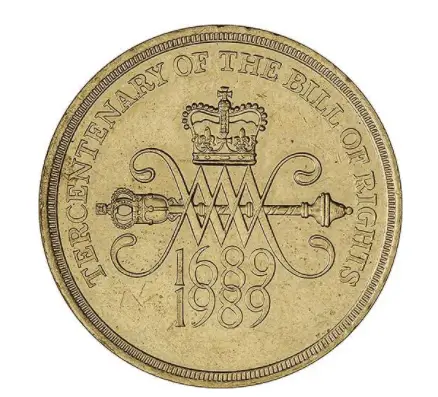The Bill of Rights £2 coin was introduced in 1989, but how much is the coin worth today if you are lucky enough to find one?
The average selling price according to the latest sold prices on eBay is about £3.11, not including postage and packaging.
Let’s take a look at the mintage and history behind the coin to see why it is sought after by coin collectors.
Bill Of Rights £2 Mintage And Rarity
There was 4,432,000 Bill of Rights £2 coins issued in 1989, although they were not intended for circulation.
In the same year, the Claim of Rights £2 coin was introduced which was much rarer and had a mintage of just 381,400.
The Bill of Rights £2 was also issued in other versions, such as silver proof, for coin collectors. The known specifications and mintages are listed below.
| Specification | Mintage |
| Silver Proof (Alongside Claim of Rights £2 in a set) | 25,000 |
| Silver Proof Piedfort (Alongside Claim of Rights £2 in a set) | 10,000 |
Design Of The Coin
The reverse of the coin features a design that was to commemorate the 300th Anniversary of the Bill of Rights.
It featured the Royal Cypher of William and Mary interlaced with letters W and M to represent King William III and Queen Mary II surmounting a horizontal Parliamentary Mace. Above is St. Edward’s Crown to represent the Royal Crown. Below are intertwined dates of 1689 and 1989.

The 1989 Bill of Rights coin was made of Nickel-brass with a 2.0 mm thickness, a diameter of 28.4 mm, and a weight of 15.98 grams. The edge of the coin is milled.
The obverse of the 1989 Bill of Rights two pound coin features the Raphael David Maklouf effigy which appeared on the obverse from 1985 to 1996.
This is considered to be the third major portrait of Queen Elizabeth II. She is facing right wearing the royal diadem which she wears on her way to and from the State Opening of Parliament. She is also wearing a pearl necklace and earrings.
The date of the British coin uncharacteristically features the date on the reverse with the value and denomination on the obverse.
What Does The 1989 Tercentenary of the Bill of Rights £2 Coin Represent?
After the Glorious Revolution in 1688, King James II of England had been overthrown. This “Bloodless Revolution” was led by William III of England.
In 1689, Prince William and Queen Mary accepted the Declaration of Rights prior to being offered the throne. The legal document stated basic civil rights and also dictated the process of the inheritance of the Crown.
This act shifted the balance of power from the Crown to Parliament and changed the course of British political history. It is still in effect to this day and is referred to in cases in the UK and throughout the Commonwealth.
Two versions of the coin were issued. One was an English version, and the other a Scottish one. The English version celebrates the Bill of Rights. Whereas, the Scottish version celebrates the Claim of Rights.
The Bill of Rights coin was minted to celebrate the Tercentenary 300th anniversary of the Declaration of Rights in 1689.
On February 13, 1689, Prince William and Princess Mary of Orange were presented with a document by the Lords and Commons that marked a major pivotal point in British parliamentary history. The document stemmed from the revolutionary events of 1688 that influenced the social, economic, and political development of democratic countries around the world. It was known as the Declaration of Rights.
The Declaration of Rights adopted a Claim of Rights (commemorated on another £2 coin) which largely corresponds to the Bill of Rights in England. In Scotland, William and Mary were recognized as King and Queen by the Convention of Estates on April 11, 1689.
The Bill of Rights was to establish free and regular elections, freedom of speech in Parliament, the proper distribution of governmental power, and protection of the rights of subjects and citizens.
The ceremonial mace gradually became a symbol of prestige and an emblem of Office throughout England.
Is The Bill Of Rights £2 Legal Tender?
Old £2 coins, including the Bill of Rights £2, are legal tender. In fact, £2 coins are legal tender up to any amount, meaning you could purchase a house legally using entirely £2 coins.
In daily life the term legal tender has a very limited meaning, however, and you’re better off keeping the coin rather than spending it as shopkeepers will likely refuse it as payment.